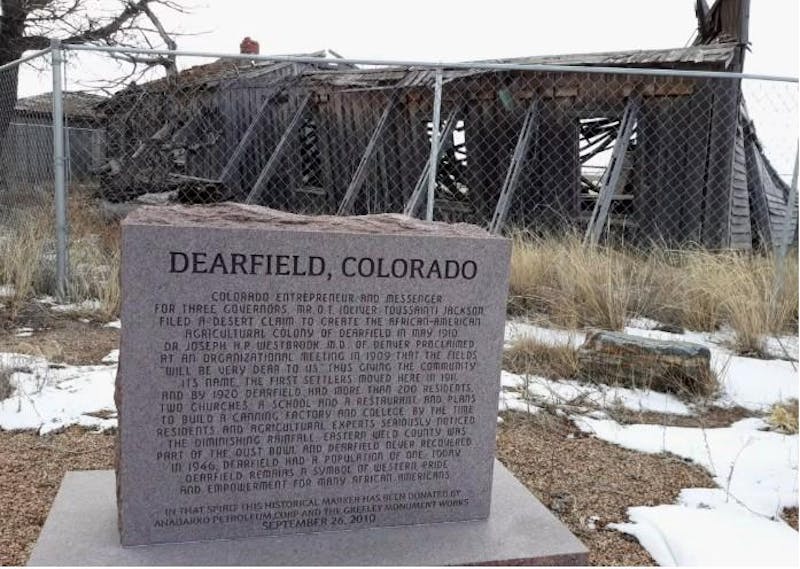Honoring the Legacy of Dearfield: A Centennial Tribute
Outside the once-bustling African American settlement of Dearfield, Colorado, a stone plaque stands as a solemn reminder of a vibrant community that flourished during the early 20th century. This year marks the 100th anniversary of Dearfield’s founding—a testament to Black independence, resilience, and the spirit of community. Scattered debris and weathered buildings may dominate the landscape today, but they tell a story rich in perseverance and courage, as efforts to preserve this historical site continue.
The Rise of Dearfield
Located just 30 miles east of the University of Northern Colorado, along U.S. Highway 34, Dearfield was established in 1910 by Oliver Toussaint Jackson, affectionately known as O.T. Jackson. Known for his skills in advertising and community organization, Jackson transformed a barren landscape into a thriving settlement where African American families pooled resources to purchase land and build homes. During its heyday from the 1910s to the 1940s, Dearfield represented a beacon of hope for many who sought to escape the pervasive racial discrimination prevalent in other parts of the country.
A Community of Hope
The settlement of Dearfield provided a refuge for African Americans, particularly as the Ku Klux Klan gained power in nearby Denver. “It was a place where many found harmony and could live joyfully among those like them,” explained Professor George Junne, who has dedicated decades to researching and preserving the history of Dearfield. His fascination with this community ignited when he first learned about it from Bill Garcia, a founding member of the Dearfield Preservation Committee.
Terri Gentry, a descendant of Dearfield landowners, reflects on the settlement as a place where her ancestors overcame racial challenges. In an Emmy-winning documentary aired by PBS, Gentry spoke to the honor she feels walking the land where her ancestors thrived despite the odds stacked against them.
Cultural Interactions and Community Bonds
One standout aspect of Dearfield’s history is the camaraderie that transcended racial divides. Junne recounts tales of Saturday night dances, where white and Black residents gathered to celebrate community through music. The lively fiddle and banjo melodies created an atmosphere where racial barriers seemed to fade, if only for a night.
The Decline: Dust Bowl and Beyond
Despite its initial success, Dearfield faced catastrophic challenges, most notably the Dust Bowl of the 1930s. “Nobody knew about the rain cycles at that time,” Junne explained, as the severe drought conditions led to widespread agricultural failure. What was once a lush farming community was devastated, resulting in the exodus of residents who could no longer sustain their livelihoods.
Unearthing History
Efforts to preserve and honor Dearfield’s history began in earnest in 2012. Excavation of the site has led to the discovery of countless artifacts, from nails and shards of glass to items as eclectic as porcelain stamped from England. One significant find includes five ledger books detailing every transaction made by O.T. Jackson, offering a glimpse into the economic life of the settlement.
Future Plans and Continued Research
As the preservation committee works diligently to restore elements of Dearfield, there are ambitious plans underway to transform the site into an educational resource. The Jackson home, alongside the old fueling station, is set to become a visitor center where people can learn about this remarkable community. Efforts are also being made to delve deeper into the land’s history, exploring the Indigenous peoples who lived in the area prior to the establishment of Dearfield.
A Broader Perspective on Racial Unity
Junne emphasizes that Dearfield is not just a chapter in African American history; it serves as a powerful narrative about racial harmony and coexistence. The settlement stands as evidence that, even in times of division, communities can forge bonds that transcend color. “This place shows that we can coexist and help each other out,” he affirmed.
By preserving and honoring the history of Dearfield, we not only pay tribute to the resilience of those who lived there but also cultivate a deeper understanding of the possibilities for unity in a divided world.
A Living Legacy
As we commemorate the 100th anniversary of Dearfield, we remember it not just as a relic of the past but as a living testament to the strength of the human spirit. The continued work of individuals like Professor Junne and the preservation committee ensures that the stories of Dearfield’s settlers will endure, inspiring future generations to recognize and uphold the values of community, independence, and resilience.



